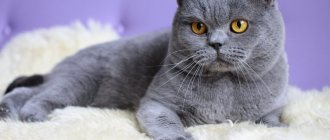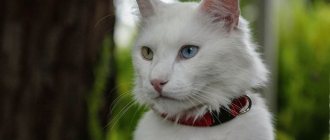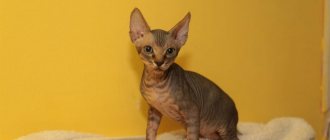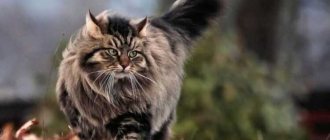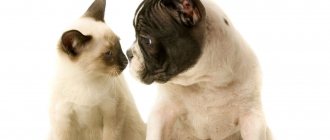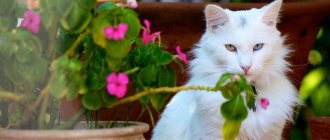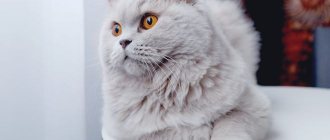If you decide to buy an unusual cat with the softest fur, you should take a closer look at the Turkish Angora. Her grace and friendliness will not leave you indifferent. In this article we will talk about the appearance and character of Turkish Angora cats, where to buy a kitten, its price in nurseries and how to care for it.
Today, purebred representatives of this breed are quite difficult to find. Due to the population decline, the Ankara Zoo launched a special breed conservation program at the beginning of the 21st century, which continues to this day.
Origin story
Angora cats are believed to have descended from their African cousins, the Egyptian cats. From them they passed on the grace and plasticity inherent in “African women”. It is believed that cats were not originally long-haired; this modification occurred much later.
However, once the Angora was brought to Europe, it was used to improve the Persian breed, which was similar to the Turkish cat. But when the best angora specimens were collected at the Antalya Zoo, felinologists decided to define them as the property of Turkey.
Until a certain point, the export of this breed outside of Turkey was strictly prohibited. Only in 1962 were they allowed to export two kittens to the USA. Then they managed to take out more individuals. Thanks to this, there were already enough representatives of the breed in Europe to register them with the American Cat Fanciers Association CFA.
The Turkish Angora should not be confused with the modern Angora cat. The Turkish Angora is an ancient cat breed native to Turkey. The modern Angora cat was developed in the 60s by crossing an Abyssinian Sorrel cat and a Siamese cat.
History of the Turkish Angora breed
Felinologists have never been able to find out exactly when and how this breed arose - Angora cats lived next to humans for many centuries.
Presumably their ancestor was the Caucasian forest cat, who lived in the Middle Ages in Turkey. The breed appeared and developed on the territory of this state, receiving its name in honor of the city of Ankara, which has been the capital since 1923. For the first time, wayward furry pets were mentioned in local legends of the 15th century. Only noble people could afford to keep white cats with bicolor eyes, although other colors were also natural. It was believed that the person who would be bitten by such an animal should become the ruler of Turkey. Another legend explaining the veneration of Angora cats says that one of the national saints had eyes of different colors. Interesting fact: modern Turkish Angoras do not look the same as their “great-grandparents”: over a long time they have undergone changes, but they have retained their extraordinary coat, grace and sophistication.
The Turkish Angora appeared in Europe at the beginning of the 17th century thanks to an Italian aristocrat. Traveling through Turkey, Persia and India, he became interested in unusual white cats with long fur. The Italian took a couple of fluffy beauties with him.
The Turkish Angora immediately became very popular, especially at the French court. It is known that one of the first owners of the Angora cat in Europe was none other than the almighty Cardinal de Richelieu. Later, equally famous Frenchmen chose pets of this breed: Louis XIV, Marie Antoinette, Victor Hugo, Théophile Gautier. The Angora cat was the favorite of the Russian Empress Catherine the Great. However, despite its popularity, no one was engaged in its systematic selection.
At the beginning of the 19th century, the breed came to the United States, but quickly became auxiliary, serving for the breeding of Persian cats. At home in 1917-1930. The Turkish Angora has been recognized as a national treasure. The government has established a program to restore the endangered breed at the Ankara Zoo nursery. The lack of systematic selection forced European and American breeders to begin rebuilding the population in the 1950s.
Officially, the Turkish Angora was recognized only in 1973 by the CFA Association (USA). Initially, only white cats were considered to meet the standard, but by 1978 it was possible to prove the traditionality of other colors. Today the breed has champion status in all world felinological organizations. To preserve the gene pool, since 1996, the Turkish government has closed the export of white Angoras from the country, but has left the possibility of exporting cats of other colors that are considered of equal value. Interestingly, in Turkey, snow-white Angora cats with multi-colored eyes are allowed into mosques.
Description of the breed
Standard
- Body : fit and elongated, medium size; males are larger than females; strong muscles; weight for males varies from 3.5-5 kilograms, and for females - 2.5-4 kilograms.
- Coat : long, with a sheen reminiscent of silk; a peculiarity is that the hair on the whole body is of different lengths, but on the tail it should be longer;
- Head : small or medium size, not very long, wedge-shaped; may be cheeks; the neck is thin and long; the chin is strong and rounded
- Eyes : large, almond-shaped; there are many color variations (blue, green, green-gold); Often there are eyes of different colors (blue and gold, green and gold, green and blue)
- Ears : large, wide at the base, set close, pointed; nose of medium length.
- Limbs: hind legs are much longer than the front ones; the paws are small and round in shape; the tail is long and pointed.
The calling card of the breed is a solid snow-white coat with characteristic pink nose and paw pads. But, besides the white color, there are other variations that are less popular:
- Black - a species characterized by a charcoal tint, a little gray undercoat on the belly; distinctive features are black and brown paw pads, as well as a black nose.
- Cream – uniform color; paws and pads have a pink tint.
- Blue – gray wool of a cold shade; The nose and paw pads are identical in tone to the coat.
- Bicolor – white coat color makes up more than 1/3 of the total color, the second color is any; The distinctive features of such cats are their white chest, belly, paws and the inside of the tail.
- Red – dark red color without spots, with well-dyed hair. The nose and pads are brick red.
- Tortoiseshell – black with red and cream spots.
- Calico is white with red and black spots.
Unacceptable colors are: chocolate, lilac, and color point.
Health
Life expectancy is 12-15 years, you can meet centenarians up to 20 years old. The Turkish Angora is considered to be a cat with average health, which can be associated with genetic diseases such as hypertrophic cardiomyopathy, ataxia and deafness.
Lack of hearing most often affects individuals with white fur. This does not mean that all white cats suffer from this disease. Most of the animals are absolutely healthy.
Ataxia is a more dangerous disease that is less common. The disease is detected in kittens at the age of 2-4 weeks. The disease is characterized by poor coordination and involuntary muscle contractions.
Another rather rare disease is hypertrophic cardiomyopathy. The diagnosis is more common in cats than in cats between the ages of 2 and 6 years.
Character
The Turkish Angora is distinguished by its special affection for people and sociality. The pet appreciates when most of the attention is paid to it. Families with children should pay attention to angora. Believe me, they will be delighted to have a small, affectionate pet who loves to play active games.
The cat is very attached to members of the household and is quite tolerant of strangers, but it takes time for the pet to completely trust a new person.
The Turkish Angora has a good hunter instinct, so it will happily catch a toy or show off its catching skills on a walk. The curiosity and activity of the breed will not let you get bored.
In addition, the Angora learns quickly. Accustoming your pet to the litter tray and scratching post will be a doable task. A more persistent owner will be able to teach her even complex commands.
The resourcefulness of this breed cannot be taken away either, so it can easily get itself a tasty morsel from the most hidden corners.
Appearance of Turkish Angora
The Turkish Angora is an elegant medium-sized cat. The flexible, elongated body is quite muscular and graceful. Females weigh 2.5-3.5 kg, males can be 2 times larger. When assessing, experts pay more attention to the balance of the physique than to the size of the animal.
Head
A flat skull and high cheekbones form a wedge-shaped head with a smooth silhouette. The forehead gently turns into a straight nose. The rounded chin in profile is perpendicular to the nose.
Eyes
Large, set wide, have a rounded, slightly oblique shape. Usually blue, green or yellow in color, individuals with differently colored eyes are often found.
Ears
Large, high-set ears have a wide base and are positioned vertically. There is a thick “brush” of fur inside, with small tassels at the ends.
Neck
The pronounced graceful neck of the Turkish Angora is of medium length.
Body
Small, fit and slender. The croup is slightly higher than the shoulders.
Legs
Slender and tall. The hind limbs are slightly longer than the forelimbs. It is desirable that there are characteristic tufts of fur between the toes.
Tail
Fluffy, almost as long as the body, tapering to a wedge-shaped tip.
Wool
The semi-long coat of the Turkish Angora is very soft, crumbly, with practically no undercoat. In the area of the “pants” and collar, the hair is slightly longer than on the rest of the body.
Color
Until today, snow-white Angora cats are in favor, but cream, brown, tabby, smoky, and red colors are also considered acceptable.
Care
Wool
The Turkish Angora's wool does not mat, as it has no undercoat, so it is enough to brush it 1-2 times a week with a special brush. In winter, when the coat becomes longer and thicker, and during shedding, brushing should be increased to 2-4 times a week.
Bathing should only be done when the coat is heavily soiled or before a show. Washing should be done using a special shampoo for white wool, which should be rinsed off thoroughly. This breed loves to swim and play in the water, so there will be no difficulties.
Nutrition
When choosing a diet, you should take into account that the food from your table is absolutely not suitable for cats, since they have a particularly sensitive digestive system. It doesn’t matter whether you choose dry food or cook it yourself for your pet. The most important criterion is the balance of food. Of course, maintaining this balance on your own is much more difficult. Super-premium and higher class foods include all the microelements that cats need.
If you still choose to make me for angora yourself, then you should adhere to specific rules. To prevent the snow-white color of the coat from giving off a yellow color, the following should be categorically excluded from the diet: liver and other offal, carrots and seaweed.
Ear and nail care
Turkish Angoras also need regular ear cleaning and nail trimming. You need to clean your ears once a week. Trim nails as they grow.
In order to have a little less problems, you should buy your pet a scratching post.
Walking your pet
Since the Turkish Angora is primarily a domestic cat, it does not need regular walking. If you are planning to take your pet for a walk, then, of course, he will be happy.
Care and maintenance
Turkish Angoras require minimal grooming. A healthy animal has a silky coat that does not tangle, so it is enough to brush it 2 times a week. White cats are bathed once every 2-3 months, using special conditioners that prevent yellowing of the coat. Pets of other colors can be washed even less often. It is necessary to regularly examine the ears and eyes of the Angora, and if necessary, wipe the shells with special lotions. Once a week you need to brush your teeth using special pastes, wipe your ears and eyes. This will avoid inflammation and the formation of tartar.
Take care of the animal's leisure time so that your pet does not spoil the furniture: buy a multi-level “cat tree”, a scratching post, and a set of toys. Get a house for your cat - personal space will become a reliable shelter for the Angora, allowing her to hide her favorite toys and just relax. If you have trained your pet to use a scratching post, there is no need to trim its nails.
This breed does not have any special dietary preferences. The most important criteria are a balanced diet and its sufficient vitamin content. Kittens should be fed 4-5 times a day, accustoming them to fermented milk products. Otherwise, you will have to buy calcium supplements to ensure normal mineralization of tooth enamel and nail growth. Adult animals need to be fed 2 times a day at strictly defined times. During the shedding period, increase your intake of fat-soluble vitamins - this will help reduce hair loss. A natural diet should include:
- fermented milk products (but not milk);
- boiled or frozen meat, offal, fish;
- raw or boiled eggs;
- vegetables.
It is not recommended to feed white Angora cats hearts, liver, seaweed - all this contributes to yellowing of the fur. This restriction does not apply to other colors. Completely protect your pet from consuming fried, peppered, too salty foods, and sweets. When choosing ready-made food, give preference to the highest quality products for long-haired cats.
Photos of Turkish Angora
Description and breed standards
The Turkish Angora cat is an elegant, medium-sized pet. The weight of male Turkish Angoras usually varies from 5 to 6.5 kg. Females weigh a little less - from 2.5 to 3 kg.
The characteristics of the Turkish Angora breed are fixed by its standard:
- The head is wedge-shaped.
- Straight nose.
- Flattened skull.
- Rounded chin.
- Long cheekbones.
- Round, slightly slanted, large eyes. Their color can be blue, green or yellow. Of particular value are pets with eyes of different colors, which is one of the characteristic features of cats of this breed.
- The large ears, set high and level, are “stuffed” with fur inside. The breed standard allows for small tufts on the tips of the ears.
- Graceful neck of medium length.
- Toned body.
- Long limbs. The front legs are slightly shorter than the hind legs.
- Fluffy tail.
- Exceptionally soft semi-long coat without undercoat.
Pets with the following characteristics are subject to disqualification: densely built body, strabismus, kinked tail.
Types and colors
The fluffy Turkish cat has several types of popular colors.
- White Angora with blue eyes and pink nose and paw pads.
- Black Angora with black or brown paw pads.
- Blue pussy with blue skin on nose and paw pads.
Tortoiseshell, brindle, red and merle colors are also acceptable. The white color was developed only in the last century. However, it is by no means the main one. Chocolate and purple coat colors are considered culling.
Breed card
| Characteristics of a cat | Notes | |
| General information | An ancient cat breed originally from Turkey, which played a key role in the formation of the Persian Longhair breed | Do not confuse the Turkish Angora with the Angora cat |
| Character | Friendly, affectionate cats, love the company of family members | Cats need time to get used to strangers |
| Appearance | Silky coat of medium length, fluffy tail. The color can be any, but white is considered traditional | Cats with white fur often have different eye colors. |
| Behavior at home | A very affectionate cat, she loves to be in the company of household members. The cat is quite curious, but does not like to leave the house | The cat spends a lot of time on personal hygiene |
| Care | The wool has no undercoat, so it does not mat. Care becomes more difficult in winter and during shedding; brushing during these periods should be increased up to 2-4 times a week. | Wool length varies throughout the year |
| Health problems | White cats with blue eyes are more likely to suffer from deafness than others. | Cats with heterochromia may be deaf in one ear. |
Character of the Turkish Angora
The Angora cat has an independent, wayward character. Usually the pet behaves calmly, but sometimes it likes to run around, knocking over everything in its path, so it is advisable to provide sufficient space for games. The cat loves mouse toys, although she will not refuse live ones. If you take away an object of fun from her during a game, she will not calm down until she takes it away or demands it back. The Turkish Angora is very persistent and purposeful. He passionately loves walks and enjoys climbing somewhere higher. This cat does not like to sit on its lap for a long time, but strives to capture the attention of those around it, while never meowing loudly or making a row, but “talks” using uterine purring sounds. The Turkish Angora gets along well with pets and family members, but considers only one person to be its owner.
Cats of this breed have a developed hunting instinct, so they happily master various toys and set up ambushes. If the owner accustoms the kitten to water procedures, the adult pet will insist on bathing. Turkish Angoras have developed intelligence, easily opening bags, cabinets, and doors if desired. Animals can also learn to fetch objects and turn lights on and off. Your pet will safely hide her own toys from prying eyes. The cat suffers without human attention, but is always ready to support its sick owner.
The Angora treats strangers with caution and takes a long time to get used to new faces. The pet is obedient, easily accustomed to the scratching post, tray and rules of behavior in the house. If for some reason an animal is offended by its owner, it will deliberately violate the established order as revenge.
How to choose a kitten
It is worth knowing that the kitten will not be returned to you from the nursery before 3 months, since only by this age are they sufficiently trained in the rules of using a tray and scratching post and are ready to part with the mother cat.
At this point, kittens should have 2 vaccinations. You can verify their presence by looking at the entries in the animal’s passport.
When choosing an individual, pay attention to the smell, cleanliness of the eyes, ears and nose. The skin should be free of rashes, peeling and redness. If your pet's stomach is unusually hard, this may indicate the presence of worms.
The price of a cat can vary greatly depending on the class and popularity of the nursery where it was purchased. Approximate cost from 5,000 to 25,000 rubles.
KENNEL NEWS IS PLACED ON THE NEWS Cattery Lada Kedi PAGE - PLEASE TAKE A LOOK!
July, 2011 I'd registered new cattery name Geraylar, co-owned by me and my daughter Sofya Linkova.
Geraylar (Arab: كرایلر , “The Girays”) are the Crimean Tatar Genghisid dynasty, which reigned in the Khanate of Crimea from its formation in 1427 until its downfall in 1783, and lived in Crimea, now Ukraine, former Russian Empire, earlier Turkish Ottoman Empire; the Girays were regarded as the second family of the Ottoman Empire after the House of Ottoman.
This way I would like to honor the memory of my grandfather Mikhail Kapliev, Crimean Tatar descendant and the brave tank commander, who didn't return from the World War II.
So former “Lada Kedi Litter D” become the first litter of my new cattery Geraylar, and kittens names are to be Geraylar A…
Geraylar Litter A born June, 3, 2011.
GERAYLAR LITTER A PICTURES ARE HERE AT THE GALLERY.
PLEASE WATCH NEW PICTURES OF THE LITTER A AT THE AGE OF 7 WEEKS HERE AT FLICKR —
Geraylar Alenushka Turkish Angora odd-eyed white female stay at the cattery.
Geraylar Ayder Geray stay at the cattery or available to show home
Sire is the Best Turkish Angora cat CFA International season 2010-2011, 15th Best Cat of Europe North Region TICA season 2010-2011, SGC, RW TICA, Junior Winner and International Champion FIFe, Champion CFA Angelicat Prince of Lada Kedi.
Dam is Grand Champion CFA Antalya'Perl Firuza of Lada Kedi, Best Turkish Angora Kitten og the International Division CFA 2010-2011.
There are 4 kittens in the litter, for today 1 white odd-eyed girl with black smoke cup, 1 black smoke female and 2 red smoke males with mackerel and classic tabby ghost markings. So enjoy the rainbow of colors!
For today(September 3):
Geraylar Ayder Geray (male cameo smoke / classic ghost markings, pedigree) – available to show home, he has the sweetest temperament to be a show star,
Geraylar Alenushka Turkish Angora odd-eyed white female kitten stay at the cattery.
The first kittens of Prince and Firuza were born on June 3, 2011 . They are registered as the first litter of the Geraylar nursery, co-owners of the nursery are me and my daughter Sofia Linkova.
See photos of kittens in the gallery on their page (click on the link to go).
Parents of kittens:
The father is the first adult of the Turkish Angora breed in Russia - Supreme Grand Champion TIKA, 15th best adult in the Northern Europe region and the second best Turkish Angora in the world TIKA - season 2010-2011, CFA Champion and Best adult Turkish Angora of the CFA International Division of the season 2010-2011 , International Champion and Young FIFe Winner Angelicat Prince of Lada Kedi is my favorite white cat Peach.
Mother - the first Turkish Angora in Russia - CFA Grand Champion, Best kitten of the Turkish Angora breed in the CFA International Division of the 2010-2011 season, Antalya'Perl Firuza of Lada Kedi, smoky tortoiseshell cat, my dear, sweet Firuza.
There are 4 kittens in the litter (1 white odd-eyed girl, 2 red smoke boys with brindle and harlequin residual tabby patterns and 1 black smoke girl). As of July 19:
Boy Geraylar Ayder Geray (Ayder Geray, pedigree, red smoke - cameo smoke / classic ghost markings, marbled residual tabby) - available , with conditions for participation in exhibitions and breeding use.
Boy Geraylar Arslan Geray (Arslan Geray, pedigree, red smoke - cameo smoke / mack ghost markings, brindle residual tabby) - sold,
The girl Aysel (black smoke) was sold, the girl Alyonushka (white, odd-eyed) remains in the nursery .
Breeding Turkish Angora
If you are planning to breed kittens, then finding a cat will not be difficult. Although the demand for cats with white fur is declining in Russia, there are still a sufficient number of popular catteries. Knitting should be done only after reaching final maturity, a period from one to one and a half years. The pregnancy itself lasts 60-63 days, usually without serious complications.
A litter usually contains 3-4 kittens.
List of nurseries where you can purchase Turkish Angora kittens:
- Iz Mira Cats – Moscow.
- Akkedi - Lyubertsy.
Conclusions about the breed
Known beyond its hometown of Ankara Zoo, the Turkish Angora is renowned throughout the world for its virtues:
- calm and affectionate character, ability to get along with small households and lack of desire to spoil interior items;
- cats have good health and a high level of immunity;
- The amazing grace, elegance and beauty of the fur do not require much care and heavy maintenance.
On the Internet, lovers share various videos about the antics of their Angoras, and it becomes clear what causes such love on the part of people.
global $ads_google; //data-ad-slot=”2475549904″ $ads_google = empty($ads_google) ? false : true; ?> if ($ads_google == false) {?> $ads_google = true; ?> } ?>
Interesting facts about the breed
- There is a legend that rulers used Turkish angora wool instead of napkins during feasts. It does not look absurd, since wool is similar to silk due to its grooming and softness.
- Some historians are of the opinion that this breed was known during the Crusades.
- The most popular are those with multi-colored eyes.
In conclusion, we can say that if you are looking for a friend who will be with the owner all day, then the Turkish Angora is considered a suitable option. Be prepared for the fact that this breed does not like to play outdoor games for a long time. He prefers cozy gatherings in a person's arms.
History of the origin of Turkish Angoras
global $ads_google;
//data-ad-slot=”2475549904″ $ads_google = empty($ads_google) ? false : true; ?> if ($ads_google == false) {?> $ads_google = true; ?> } ?> The history of the origin of the Turkish Angora is the most natural. There are legends about the breed: one of them says that the Prophet Muhammad had eyes of different colors, and since this phenomenon also often occurs in these beautiful creatures, cats are sacred.
The second legend is associated with the name of the national hero of Turkey Mustafa Kemal Ataturk. Ataturk also had eyes of different colors, and he said that whoever was bitten by the odd-eyed angora would follow in his footsteps. It becomes clear the respect that surrounds a cat in its actual homeland.
Although if you delve into the history of the breed, then most likely the cat arrived in Asia from Africa, probably from Egypt. Europe saw creatures with long white hair and different eyes during the Crusades.
The popularity of cats of this breed made them universal favorites outside of Turkey, in Europe, Russia and then in the USA. They began to be used in breeding the Maine Coon and Persian breeds, but Angora cats became the property of the country.
This breed has European and American varieties and hence a large variety of different colors.
How much does a Turkish Angora cost?
The average price for an Angora kitten is 15,000 rubles.
The cost of an Angora is influenced by the class of the pet, the reputation of the nursery or breeder, and the conditions under which the animals are kept.
The minimum cost of a non-show pet is 8,000 rubles. Elite pussies will cost from 25,000 rubles.
Where to buy and how to choose
Since in recent years, cases have become more frequent when unscrupulous breeders, under the guise of a purebred pet, sell mixed-breed Angora cats and other culls, felinologists advise buying a Turkish Angora kitten from well-known nurseries.
Cattery staff will be able to provide potential cat owners with all the necessary documents for the little purr: pedigree, vaccinations, veterinary passport.
When choosing a future pet, you should give preference to a playful pet at least 3 months old with clean ears and eyes.



